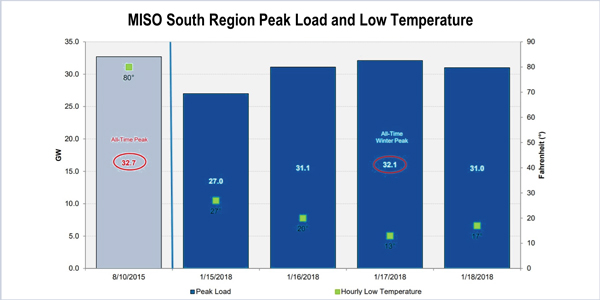By Amanda Durish Cook
CARMEL, Ind. — MISO maintained reliable operations in its South region during a record January cold snap that saw the area’s peak loads approach summertime highs, the RTO said last week.
Tim Aliff, MISO director of system operations, provided a post-mortem of the event at a Feb. 8 Market Subcommittee meeting. He recounted that a second blast of arctic air hit MISO South in mid-January, less than two weeks after extreme cold had gripped most of the RTO’s footprint and sent peak demand well above 100 GW. (See MISO Breaks down Recent Cold Snap.)
Uncharacteristically frigid weather prompted MISO to initiate a maximum generation alert for the South region for Jan. 17-18, when the region’s peak loads were hovering above 31 GW. With low temperatures averaging 13 degrees Fahrenheit on Jan. 17, MISO South’s peak load hit 32.1 GW, just short of the region’s all-time high of 32.7 GW set in August 2015.
Throughout the day on Jan. 17, MISO South temperatures remained about 20 to 25 degrees lower than normal. MISO committed all available resources in the region, compelling load-serving entities to make emergency energy purchases from neighboring balancing authorities between about 7:25 a.m. and 12:55 p.m., with purchases topping at about 1.1 GW around 8 a.m. Aliff said MISO’s emergency pricing floors worked as designed when initiated on Jan. 17, with average LMPs spiking just above $1,000/MWh during the peak of buying.
MISO South analysts also reported about 17 GW of generation outages and derates that day, including nearly 10 GW in forced generation outages, further stressing the region’s system, Aliff said. By then, Louisiana and the Gulf Coast were ensnared in what the Weather Channel would dub Winter Storm Inga.
MISO asked for South utilities to undertake load management measures, prompting Louisiana state regulators to question the need for conservation. (See Louisiana Regulators Question MISO South Max Gen Event.) MISO South has no registered emergency demand response resources within its boundaries.
Aliff said MISO will continue to review the event to determine what process improvements it could make as it heads into summer, when more emergency conditions are likely to occur. He said MISO has yet to analyze the load-modifying resource performance in MISO South during the weather event.






